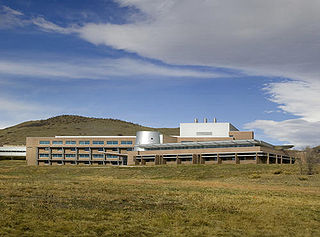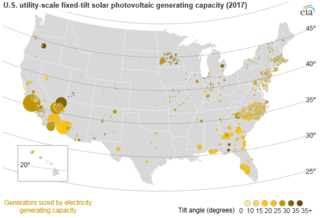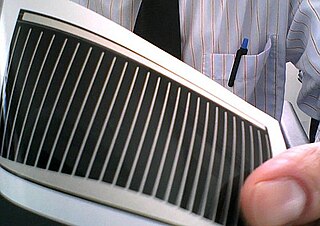Related Research Articles

The National Renewable Energy Laboratory (NREL) in the US specializes in the research and development of renewable energy, energy efficiency, energy systems integration, and sustainable transportation. NREL is a federally funded research and development center sponsored by the Department of Energy and operated by the Alliance for Sustainable Energy, a joint venture between MRIGlobal and Battelle. Located in Golden, Colorado, NREL is home to the National Center for Photovoltaics, the National Bioenergy Center, and the National Wind Technology Center.
In the 19th century, it was observed that the sunlight striking certain materials generates detectable electric current - the photoelectric effect. This discovery has laid the foundation of solar cells. Solar cells have gone on to be used in many applications. They have historically been used in situations where electrical power from the grid was unavailable.

A solar cell, or photovoltaic cell, is an electrical device that converts the energy of light directly into electricity by the photovoltaic effect, which is a physical and chemical phenomenon. It is a form of photoelectric cell, defined as a device whose electrical characteristics, such as current, voltage, or resistance, vary when exposed to light. Individual solar cell devices are often the electrical building blocks of photovoltaic modules, known colloquially as solar panels. The common single junction silicon solar cell can produce a maximum open-circuit voltage of approximately 0.5 volts to 0.6 volts.
Energy Conversion Devices (ECD) was an American photovoltaics manufacturer of thin-film solar cells made of amorphous silicon used in flexible laminates and in building-integrated photovoltaics. The company was also a manufacturer of rechargeable batteries and other renewable energy related products. ECD was headquartered in Rochester Hills, Michigan.

A quantum dot solar cell (QDSC) is a solar cell design that uses quantum dots as the absorbing photovoltaic material. It attempts to replace bulk materials such as silicon, copper indium gallium selenide (CIGS) or cadmium telluride (CdTe). Quantum dots have bandgaps that are tunable across a wide range of energy levels by changing their size. In bulk materials, the bandgap is fixed by the choice of material(s). This property makes quantum dots attractive for multi-junction solar cells, where a variety of materials are used to improve efficiency by harvesting multiple portions of the solar spectrum.
MiaSolé is an American solar energy company selling copper indium gallium selenide (CIGS) thin-film photovoltaic products. MiaSolé's manufacturing process lays CIGS on a flexible stainless steel substrate. MiaSolé produces all layers of photovoltaic material in a continuous sputtering process.

Solar power in the United States includes utility-scale solar power plants as well as local distributed generation, mostly from rooftop photovoltaics and increasingly from community solar arrays. As of the end of 2021, the United States had 121,475 megawatts (MW) of installed photovoltaic and concentrated solar power capacity combined. In 2018, utility-scale solar power generated 66.6 terawatt-hours (TWh), 1.66% of total U.S. electricity. During the same time period total solar generation, including estimated small-scale photovoltaic generation, was 96.1 TWh, 2.30% of total U.S. electricity. In terms of total cumulative installed capacity, by year end 2017 the United States ranked 2nd in the world behind China. In 2016, 39% of all new electricity generation capacity in the country came from solar, more than any other source and ahead of natural gas (29%). By 2015, solar employment had overtaken oil and gas as well as coal employment in the United States. In 2016, more than 260,000 Americans were employed in the solar industry.

Michael Grätzel is a professor at the École Polytechnique Fédérale de Lausanne where he directs the Laboratory of Photonics and Interfaces. He pioneered research on energy and electron transfer reactions in mesoscopic-materials and their optoelectronic applications. He co-invented with Brian O'Regan the Grätzel cell in 1988.

Cadmium telluride (CdTe) photovoltaics is a photovoltaic (PV) technology based on the use of cadmium telluride in a thin semiconductor layer designed to absorb and convert sunlight into electricity. Cadmium telluride PV is the only thin film technology with lower costs than conventional solar cells made of crystalline silicon in multi-kilowatt systems.

A thin-film solar cell is a second generation solar cell that is made by depositing one or more thin layers, or thin film (TF) of photovoltaic material on a substrate, such as glass, plastic or metal. Thin-film solar cells are commercially used in several technologies, including cadmium telluride (CdTe), copper indium gallium diselenide (CIGS), and amorphous thin-film silicon.

A copper indium gallium selenide solar cell is a thin-film solar cell used to convert sunlight into electric power. It is manufactured by depositing a thin layer of copper, indium, gallium and selenium on glass or plastic backing, along with electrodes on the front and back to collect current. Because the material has a high absorption coefficient and strongly absorbs sunlight, a much thinner film is required than of other semiconductor materials.
Narec, since 2014 known as the National Renewable Energy Centre, is a part of the Offshore Renewable Energy (ORE) Catapult, a British technology innovation and research centre for offshore wind power, wave energy, tidal energy and low carbon technologies. ORE Catapult's head office is in Glasgow, Scotland. The centre operates multi-purpose offshore renewable energy test and demonstration facilities. It is similar to other centres, such as NREL in the US and National Centre for Renewable Energies (CENER) in Spain. The National Renewable Energy Centre is based in Blyth, Northumberland.
Arthur J. Nozik is a researcher at the National Renewable Energy Lab (NREL). He is also a professor at the University of Colorado, which is located in Boulder. He researches semiconductor quantum dots at the National Renewable Energy Laboratory, and is a chemistry professor at the University of Colorado. He also does research for the advancement of solar energy, for which he won the Intergovernmental Renewable Energy Organization (IREO) Award for Science and Technology in 2009.
Amonix, Inc. is a solar power system developer based in Seal Beach, California. The company manufactures concentrator photovoltaic (CPV) products designed for installation in sunny and dry climates. CPV products convert sunlight into electrical energy in the same way that conventional solar photovoltaic technology does, except that they use optics to focus the solar radiation before the light is absorbed by solar cells. According to a comparative study of energy production of solar technologies, CPV systems require no water for energy production and produce more energy per megawatt (MW) installed than traditional PV systems. Amonix has nearly 70 megawatts of CPV solar power systems deployed globally, including Southwestern U.S. and Spain. In May 2012, the Alamosa Solar Generating project, owned and operated by Cogentrix Energy, began commercial operation. This is the largest CPV power plant in the world and is expected to produce enough clean renewable energy per year to power more than 6,500 homes and will avoid the emissions of over 43,000 metric tons of carbon dioxide per year. The Alamosa Solar Generating Project is supported by a power purchase agreement (PPA), which is a long-term agreement to sell the power it will generate. Under the project's PPA, the Public Service Company of Colorado will buy the power generated by the solar facility for the next 20 years. In July 2012, Amonix set the world record for photovoltaic module efficiency at 33.5% under nominal operating conditions, verified by the National Renewable Energy Laboratory. In April 2013, Amonix broke the record set in July 2012, demonstrating photovoltaic module efficiency at 34.9% under normal concentrator standard operating conditions, also verified by the National Renewable Energy Laboratory. In August 2013, Amonix announced it had achieved a 35.9% photovoltaic module efficiency rating under concentrator standard test conditions (CSTC) as calculated by NREL. In June, 2014, the assets of Amonix were acquired by Arzon Solar, LLC for the purpose of continued development of CPV technology and products.

Antonio Luque López is a Spanish scientist and entrepreneur in the field of photovoltaic solar energy. In 1979 he founded the Institute of Solar Energy of the Technical University of Madrid (IES-UPM) and was its director till his retirement in 2017; he is currently its honorary president as well as professor emeritus in this university. He invented the bifacial solar cell in the late 1970s, today one of the mainstream solar cell technologies, and founded Isofoton in 1981 for its industrial production. He is, arguably, one of the fathers of the science and technology of concentrator photovoltaics and has been active in the research and development of high-efficiency photovoltaic conversion devices, inventing the intermediate band solar cell.

Amorphous silicon (a-Si) is the non-crystalline form of silicon used for solar cells and thin-film transistors in LCDs.
Pauls Stradiņš Jr. is a physicist at the National Renewable Energy Laboratory in Golden, Colorado, and a foreign member of the Latvian Academy of Sciences.

Subhendu Guha is an Indian American photovoltaic scientist who invented flexible Solar shingles. He is known for his pioneering work in Amorphous silicon and Nanocrystalline silicon. In 1998 Dr Guha invented flexible solar cells that can be directly applied to residential roof tops.

At the time of commissioning in 2003, the 500 kW Chevron Solarmine solar photovoltaic (PV) system was the world's largest thin-film amorphous silicon solar PV system and one of the largest solar PV systems in the United States. Located at the Midway-Sunset Oil Field, Solarmine was the first solar PV system in California to power oil field operations.
Seth B. Darling is the director of the Center of Molecular Engineering, a research and development program focusing on advanced materials for cleaning water, quantum information science, and polymer science. Darling is also a senior scientist at both the U.S. Department of Energy’s (DOE) Argonne National Laboratory and the University of Chicago’s Pritzker School of Molecular Engineering. He also directs the Advanced Materials for Energy-Water Systems (AMEWS) Center, a DOE Energy Frontier Research Center formed in 2018.
References
- 1 2 Sarah Kurtz — Research Fellow, National Renewable Energy Laboratory, archived from the original on 2017-04-30
- 1 2 3 Anderson, Lorena (February 13, 2020), "National Academy of Engineering Elects Kurtz Into Its Ranks", Newsroom, University of California, Merced, retrieved 2020-10-26
- 1 2 "Sarah Kurtz", School of Engineering Faculty, University of California, Merced, retrieved 2020-10-26
- ↑ WorldCat catalog entry for Atmospheric pressure chemical vapor deposition of hydrogenated amorphous silicon, titanium nitride, and titanium dioxide thin films, retrieved 2020-10-26
- ↑ NREL Scientists Win Dan David Prize in Future Category, National Renewable Energy Laboratory, March 6, 2007, retrieved 2020-10-26; "2 NREL scientists take share of Dan David prize", Denver Post, March 6, 2007; "Laureates 2007", Dan David Prize, retrieved 2020-10-26
- ↑ NREL's Sarah Kurtz Wins Prestigious Cherry Award from IEEE, National Renewable Energy Laboratory, June 7, 2012, retrieved 2020-10-26
- ↑ "Sarah Kurtz, 2016 winner", Lifetime Achievement Award, US Clean Energy Education & Empowerment (C3E) Initiative, retrieved 2020-10-26
- ↑ "Professor Sarah Kurtz", Member profiles, National Academy of Engineering, retrieved 2020-10-26